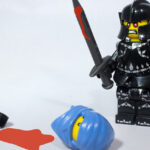Wisdom consists in being able to distinguish among dangers and make a choice of the least harmful. – Niccolò Machiavelli

Choose wisely, from the incredible selection of foods before you. Failing to choose may result in eating too much. Do you favor the meats or the vegetables? How much room will you save for dessert? Thinking it through (including the consequences of eating the foods you love, but which hate you) is crucial if you are to make a wise decision.
What does that mean?
This may be another fake quote, as I have seen it attributed in many places, but cannot find it in The Prince, where it is alleged to be from. Perhaps it’s just a translation issue, but it’s still and interesting quote.
This says that it is important to be able to first notice and quantify the dangers related to each choice when making a decision. The quote then states that it is then important to be able to distinguish between the differing levels and types of dangers and make a choice.
Not all dangers are created equal. In a particular decision, one option might be dangerous to your health, another option might be dangerous to your wealth, and yet another option might be dangerous to your standing in the community. Which is the most likely, and which are you most willing to risk? The ability to make that choice with diligence, prudence, and rapidity is what this quote calls wisdom
Why is choosing well important?
Any fool can choose by random chance. Most living things tend to do a little better than that, as they gain experience through their lives. But choosing well is something that takes a little effort.
Yes, sometimes we go with a “gut feeling” or an intuition or some sort of similar method of choosing. And it may be one of our more successful methods (it has been for me, at least).
However, it seems that we don’t always get direction from our gut (at least I don’t). With that said, how do we make well thought out decisions? That was a leading question, of course.
Thinking about the possibilities, and the dangers (or down sides) associated with each option, will help us come to the best possible solution for our situation.
Where can I apply this in my life?
Thinking about what our choices are can help us make better decisions. If we can think beyond “hungry, therefore eat” we can do even better. What kind of food is there? What are your dietary needs? When did you last eat? What is nearby (either where you are, or in the neighborhood, or just down the road, or…)?
Answering some of these questions might direct you away from the junk food and into the refrigerator for a salad. You might even think a little farther ahead and decide you really want those cookies, but need to watch your weight, so you’ll do a lap around the block first, and then dig into the cookies.
So, first you have to notice that there is a choice to be made, because if you don’t, you’ll just coast through the decision point, and something will be chosen, but it will be random or at least not thought out, right?
If you have determined that there is a choice to be made, it’s time to strap on our thinking caps and try to come up with options. What can you do, which direction can you go, how far will you go, can you get help?
Once you get that far, it’s time to explore each of the different choices (or at least the ones you believe to be the best options). Consider what you want to accomplish, and the pro’s and con’s of each option.
Next, if you can continue to think about the choices, look into the future and see what other dangers might be lurking just past this decision. If you spend money today, you won’t have it tomorrow. Were you planning to go out, perhaps a dinner and a movie? Perhaps you might want to reconsider.
If you’re still working on your choices, the final step (according to the quote) is to distinguish between (or among) the dangers. Implied in the quote is weighing the options, and then selecting the one that gives the best possible outcome with the least danger.
Sounds easy, right? But we all have different thresholds for tolerating danger, and danger comes in many forms. These will be very personal decisions, but if you can think well, and distinguish among the dangers, you can make a wise decision.
What will you choose to do?
From: Twitter, @fit911
confirmed at : http://www.iperceptive.com/authors/niccolo_machiavelli_quotes.html It is the 10th quote listed on Page 1.
Photo by flickr4jazz






